#tyrosinase
Text
so i’m kind of panicking right now because i’m doing a science fair project on the gene that gives siamese cats the color pattern in their fur and we waited too long to infiltrate the siamese cats facebook group and now i don’t have the pictures i need for data collection so if anyone has a siamese cat, especially if it’s an outdoor cat, would you be willing to send pictures? I need two pictures, one taken in the summer and one in the winter, both with the same limb visible, and I need to know whether the cat lives indoor or outdoor and about where the cat lives - preferably as a line of latitude. I will trade pictures of my cats if you would like.
#cats#siamese#siamese cats#science fair#biology#genetics#tyrosinase#please guys i wasn't kidding when i said i was panicking#i'm kind of desperate#help me#photography#cat pictures#siamesecats#siamesekitten#cat pics#albinism#not quite but sort of#genetic mutation#high school#school problems#facebook#facebook science#but correct#my cats#tabby cats#dumb cat#kitten eyes#whatever tags it takes to get this in front of people within moral reason#i'm about this close to tagging it batman though#i'm that desperate
27 notes
·
View notes
Text
TYR
RYT
1 note
·
View note
Text
Cat color genes masterpost
I copied all my descriptions from the cat color gene tournament here, with pictures and all. I often type out the genotypes, so this is a guide to what each letter means. Under the cut because it's very long.
Disclaimer: Sometimes I don't use the most common designations of a gene or an allele, and I'd like to apologize to everyone who's bothered by this. I have a very good reason for it: I like it better my way.
Genetics guide
Agouti (agouti signaling protein gene, ASIP): this gene determines whether the individual hairs will be banded or not.
dominant allele: A - banded hairs, tabby cat (wild type)
recessive allele: a - no bands, solid cat (variant)

A_ means if there's already an A allele, the other one can be either A or a.
A homozygous recessive cat with wild type alleles on every other gene will be solid black. Combined with other allele variants the a allele can produce other solid colors, different types of smokes and several more.
Actually there are more "secret" alleles for this gene: the agouti alleles of the asian leopard cat and other wild feline species. In certain hybrid breeds, most notably bengals, there's even a special coloration called charcoal born from the combination of the domestic cat's solid and the asian leopard cat's agouti allele.
Ticked (dickkopf wnt signaling pathway inhibitor 4, DKK4): this gene determines if there is any full-colored hairs, or only banded.
dominant allele(s - researchers found at least two): Ti - only banded hairs, ticked tabby cat (variant)
recessive allele: ti - some hairs don't have bands, "patterned" tabby cat (wild type)

If this is the only gene with variant allele, we'll have a black ticked tabby [black tabbies are also called brown, and other, mostly breed-specific names]. Ticked tabbies are possible in every color.
Nonagouti covers up the tickedness (this is called recessive epistasis): we won't see what a solid cat's genotype is on this gene. (Except when other genes make it possible. But that's biology for you.)
Spotted (?): this hypothetic gene can break up the tabby pattern's stripes into spots.
dominant allele: Sp - spotted tabby cat (variant)
recessive allele: sp - striped tabby cat (wild type)
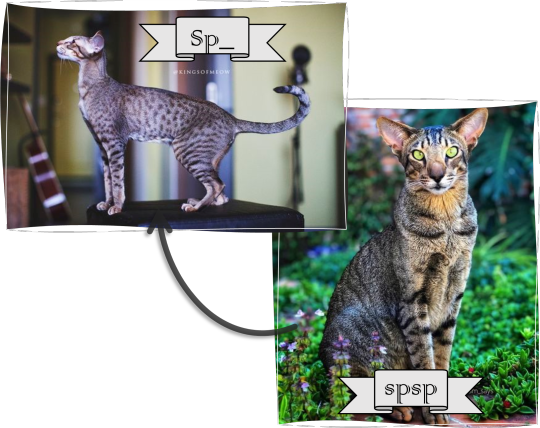
Alone the Sp allele makes a black (brown ect) spotted tabby cat; of course, in combinations with other variant alleles, it can produce a wide variety of different colored spotted tabbies.
Both a and Ti covers up the spotted gene: its effect normally only visible on a cat with the A_ titi genotype.
Mackerel [i use the name mackerel since every other gene here is named after the dominant allele] (transmembrane aminopeptidase Q, Taqpep): this gene determines the type of the tabby pattern.
Blotched and classic are synonym terms.
dominant allele: TMc - narrow vertical lines, mackerel tabby cat (wild type)
recessive allele: tbl - wide, swirling lines, blotched or classic tabby cat (variant)
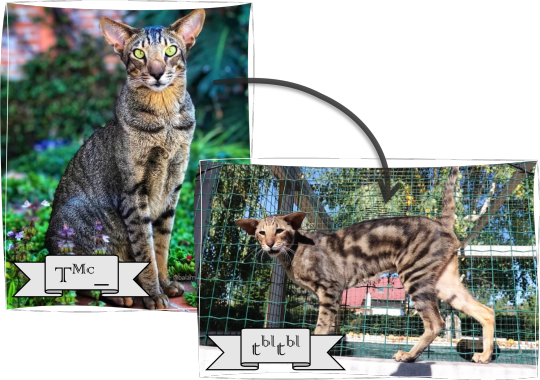
If every other gene is wild type except this, we'll have a black blotched tabby cat, but of course the tbl allele can produce lots of different colored classic tabbies.
All of the previously mentioned genes are able to nullify the effect of this one, so a mackerel or a blotched tabby must have A_ titi spsp genotype.
Additional annoyed remark: Despite the name, the so-called classic pattern is actually both the newer and the less common worldwide. My only guess for why it's named like that: it's the more common one in England. Well, thanks. (That's why I actually prefer the name blotched over classic.)
Brown (tyrosinase-related protein-1, TYRP1): this gene determines the quantity of the functional eumelanin.
dominant allele: B - full pigment production, black cat (wild type)
"middle" allele: b - less pigment, chocolate cat (variant)
recessive allele: bl- even less pigment, cinnamon cat (variant)
Order of dominance: B > b > bl
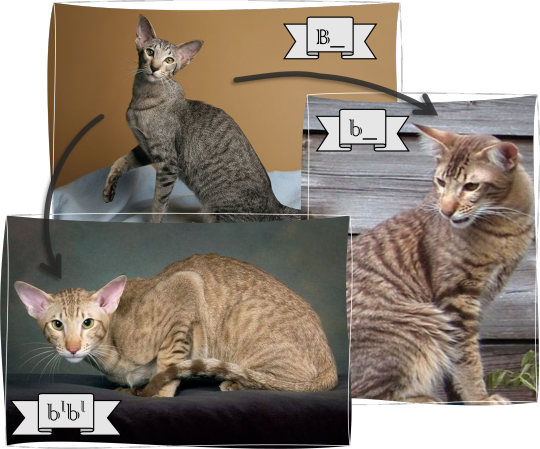
If every other allele is wild type except this, we'll have a chocolate or cinnamon mackerel tabby cat. (On the picture the cinnamon cat is spotted rather than striped, because i couldn't find a decent mackerel. So sad.) Chocolate and cinnamon cats are possible in every pattern.
Dilute (melanophilin, MLPH): this gene determines the distribution of the pigments.
dominant allele: D - even pigment distribution, dark cat (wild type)
recessive allele: d - clumped, uneven pigment distribution, diluted cat (variant)
black -> blue
chocolate -> lilac
cinnamon -> fawn

In these pictures the difference isn't that striking between the black and the blue mackerel tabby, but if you look up at the header, in solid cats it's much more pronounced.
For further comparison of undiluted and diluted color pairs on one picture (to eliminate differences in lightening):
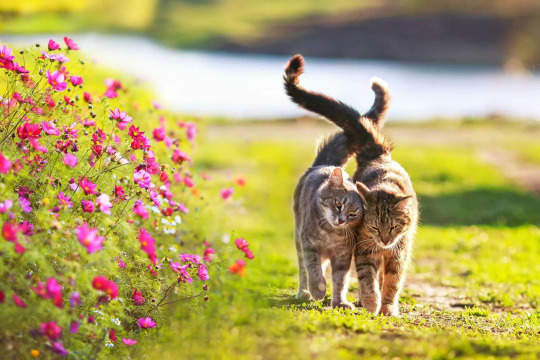

black vs blue and red vs cream
Every possible color and pattern can be diluted (with the only exception of white).
Orange (?): this yet unidentified gene determines the type of the most prominent pigment: eumelanin on pheomelanin.
allele: O - mainly pheomelanin, red-based cat (variant)
allele: o - mainly eumelanin, black-based cat (wild type)
This gene is special in two related ways: first, it's located on the X chromosome, which means tomcats only have one allele; second, the alleles are codominant - if a cat carries both of them, it'll show both phenotypes: this is how we get tortoiseshell cats. This explains why almost all tortoiseshell cats are females - every tortie needs two different X chromosomes.

Combined with other variant alleles every possible color and pattern can occure as tortoiseshell, but the O allele is epistatic over a lot of genes: for example agouti (the phenotype of every orange cat is tabby, even the genetically solid ones) and brown (since eumelanin is mostly absent thus can't change - the genotypes OO B_, OO b_and OO blbl all mean red cat).
The dilute version of red is called cream.
The dilution level is always the same in the colors of a tortoiseshell: the undiluted black, chocolate and cinnamon is paired with red, the diluted blue, lilac and fawn are paired with cream.
White (receptor tyrosine kinase, KIT): this gene determines the size of the area the pigment producing cells (the melanocytes) reach.
dominant allele: W - basically no melanocytes, white cat (variant)
allele(s): ws - limited area is covered, white-spotted cat (variant)
allele: w - all of the body is covered by the melanocytes, full-colored cat (wild type)
recessive allele: wg - only the paws remain white, gloved cat (variant)
Order of dominance: W > ws = w > wg

Since the gloving allele is kind of specific to the breed, I used a birman cat to illustrate it.
Lots of alleles here! Actually I'm not sure what's the most accepted opinion about them, but since these variant are all mapped to KIT, I considered them alleles.
If every other gene shows the wild type except for this, we'll have a white, or a white-spotted black mackerel tabby cat, but thanks to the ws allele(s) every color and pattern can be combined with white patches. However, the W allele is epistatic over every other gene: if a cat has one or two copies of W, it will be white regardless everything else.
ws is interesting: it has an additive effect, a cat with the wsws genotype will have more white than a cat with only one copy of it.
wg is fully recessive: the gloved phenotype only present if the cat's genotype is wgwg.
Color restriction (tyrosinase, TYR): mutations on this gene will result in temperature-sensitivity in the pigment production, the cats will be lighter on the warm and darker on the cooler areas of their bodies.
dominant allele: C - regular pigment production, full colored cat (wild type)
allele: cb - moderately reduced pigment production: burmese color restriction, sepia cat (variant)
allele: cm - reduced pigment production, bangkok color restriction, mocha cat (variant)
allele: cs - highly reduced pigment production: siamese color restriction, pointed cat (variant)
recessive allele: c - no pigment production, albino cat (variant)
Dominance order: C > cb = cm = cs > c
Now this group is a lot. Not only five different alleles (mocha was found relatively recently in Thailand), but the middle three are all intermediate with each other meaning that actually we have eight different phenotypes (illustration from messybeast; full color and albino are absent):

I used solid cats for illustration, because in the thai breed (the cats i used belong to this) they are often preferred over tabbies, so it's easier to find pictures; also, it's much more simple to compare them.
(Photos from The Thai Cat Center and Bangkok Mocha Cat, and Pangur from @pangur-and-grim as an albino cat)
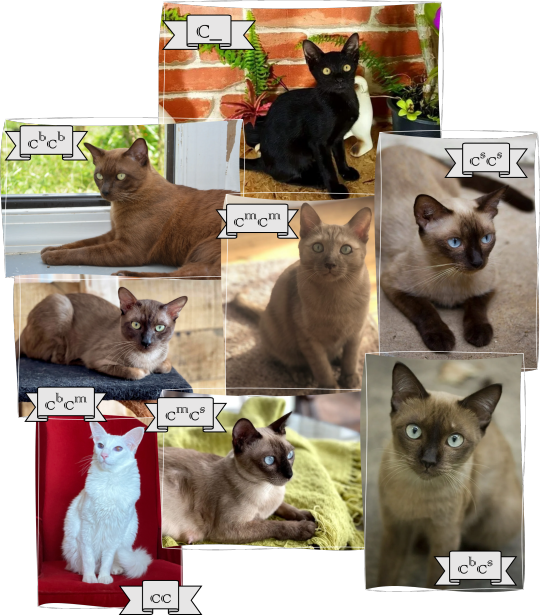
Please note that all of these varieties are very changeable; the pictures (especially those of the heterozygotes) are far from representing all cats carrying the respective genotypes.
Alone these variants makes some type of a black (seal) mackerel tabby point cat, but every type of color restriction can occure together with all possible colors and patterns.
***The color restriction gene won the Cat Color Gene Tournament!***
Inhibitor (?): this unidentified gene reduces the pheomelanin production, thus removes the warm tones of the fur (the hairs have white-black banding instead of yellow-black).
dominant allele: I - reduced pheomelanin, cooler toned cat (variant)
recessive allele: i - normal pheomelanin, warmer toned cat (wild type)

If every other allele is wild type except for this, we'll have a black silver mackerel tabby cat. Combined with other alleles it can produce lots of different silver (tabby) and smoke (solid) varieties.
Wide band (?): This hypothetic gene makes the yellow bands on the agouti hairs wider, resulting in a lighter, yellowish pelt. Based on the width of the pale bands we can differentiate between golden (middle band width) and shaded (maximal band width, color is pushed up into the tip).
dominant allele: Wb - reduced area of eumelanin, warmer toned cat (variant)
recessive allele: wb - normal area of eumelanin, cooler toned cat (wild type)

Golden is quite a mess; right now there is one identified gene (found first in siberians), but persians and many more breeds must have different gene(s), based on the interaction with the inhibitor gene (siberian golden + silver = bimetallic, persian golden + silver = silver shaded or chinchilla), and the inheritance patterns (the siberian alleles are recessive, while persian golden appears to be dominant). Since lots of breeds allow golden, and sometimes it can be found even in stray cats, I say who knows what genes and alleles are out there! This is all a hardly understood, very exciting and currently researched area.
If every other gene stays wild type except for this, we'll have a black golden mackerel tabby or a black golden shaded cat. Combined with other alleles it can produce lots of different golden and silver varieties.
Low-grade white (?): Again, hypothetic gene(s). Even with the extreme variability of the white spotting allele(s), the existence of some independently inherited genes is strongly suspected. Their effects most commonly manifest as a white locket: a small white patch on the chest or the belly, and/or a white tail tip. I'm not sure if there is any consensus whether these are more likely to be recessive or dominant alleles.
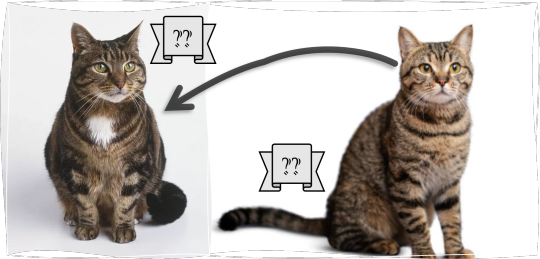
Dilute modifier (?): This unidentified gene changes the color of a diluted cat, the coloration becomes more brownish.
dominant allele: Dm - (variant)
recessive allele: dm - (wild type)
blue, lilac, fawn -> caramel
cream -> apricot
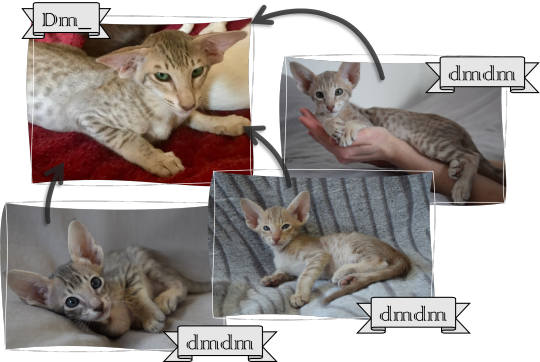
I put here a cat in all three diluted colors to compare them with the caramel tabby. It's hard to spot the differences, isn't it?
Since this is a dilute modifier, the D allele covers it, and we can only see its effect on cats with dd genotype.
It can be found only in a few breeds: orientals (including related breeds), burmese, different rexes. To our current knowledge, of course.
Extension (melanocortin 1 receptor, MC1R): This gene replaces eumelanin with pheomelanin resulting in a yellowish or reddish furred cat. The change often happens gradually during the first years of the cat's life.
dominant allele: E - eumelanin remains, black adjacent cat (wild type)
recessive alleles: e, er, ec - pheomelanin takes over, yellow/red adjacent cat: amber, russet or serdolik (variant)
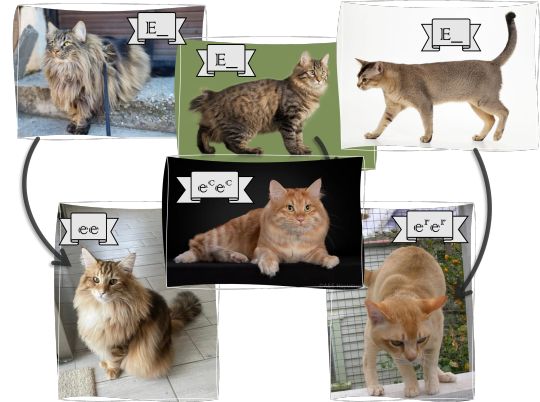
All three recessive variants are new mutations found recently in different breeds: the color amber in the 1990s in norwegian forest cats, the color russet in 2007 in burmese, and the color carnelian or serdolik in 2018 in kurilian bobtails (at least that's the first mention). We don't know anything about their interactions, or their effects on cats outside of their respective breeds.
The gene only effects eumelanin, so the O allele is epistatic over the it. However, because of the properties of the overpowering pheomelanin, every e allele is epistatic over agouti, so the tabby patterns will show up on aa cats as well.
Wide band (serine peptidase, CORIN): This hypothetic gene makes the yellow bands on the agouti hairs wider, resulting in a lighter, yellowish pelt.
dominant allele: Wb - eumelanin on normal sized area, darker cat (wild type)
recessive alleles: wbSIB, wbeSIB, wbBRI - eumelanin on reduced area, lighter cat (variant)

Ohhh, citizens of tumblr, we're really in it now. So. In the moment, we have, I believe, three mutations found on this gene: the sunshine (wbSIB) and extreme sunshine (wbeSIB) in the siberian breed, and the copper (wbBRI) in british cats. (I only show the sunshine and the copper here.) The novelty of these mutations means that the breeders still often call them simply golden instead of the new names, so it's difficult to find reliable data. Further complicating the situation, most likely both breeds have more wide band gene(s) beyond CORIN, and especially the copper cat above is the result of the combination of several wb genes.
Karpati (?): This unidentified gene makes the extremeties (face, ears, legs, tail) white kinda like a reverse colorpoint cat, and causes a roaning effect: scatters white hairs everywhere on the body.
dominant allele: K - whited extremities, karpati cat (variant)
recessive alleles: k - normal pigmant production, full colored cat (wild type)

Karpati seems to show intermediate inheritance with significantly more white on a homozygous then a heterozygote cat. This gene is studied for a very short time, and mostly on heterozygotes since they are much more common. The cats appearence changes during their life and also with the seasons: they born very similar to a fever coated kitten but with white ears, then to the end of their first year they almost completely lose the white (at least the heterozygous cats - the homozygotes become darker but still keep strange white patterns), then slowly gain it back as they age.
The karpati mutation is present in the stray cat population in middle-east Europe (including Hungary where I live, wahoo! and indeed, I can regularly see one or two karpaties in facebook adoptions groups and such). It's also introduced to some established breeds (LaPerm, Sphynx ect) and the creation of its own breed also began under the Transylvanian name.
2K notes
·
View notes
Text
Phytochemical characterization and mushroom tyrosinase inhibition of different extracts from Salvia officinalis L. leaves
Phytochemical characterization and mushroom tyrosinase inhibition of different extracts from Salvia officinalis L. leaves. #Pharmacy #Pharmacology #Pharmacognosy #NaturalProducts #TraditionalMedicine
Image: Flickr
Article published in the J. Pharm. Pharmacogn. Res., vol. 10, no. 4, pp. 605-615, July-August 2022.
Lana Y.M. Juee
Department of Pharmacognosy, Pharmacy College, Hawler Medical University, Erbil, Kurdistan Region, Iraq.
*E-mail: [email protected]
Abstract
Context: Sage (Salvia officinalis) is an ancient valuable plant used in the treatment of variant health issues.
Aims:…
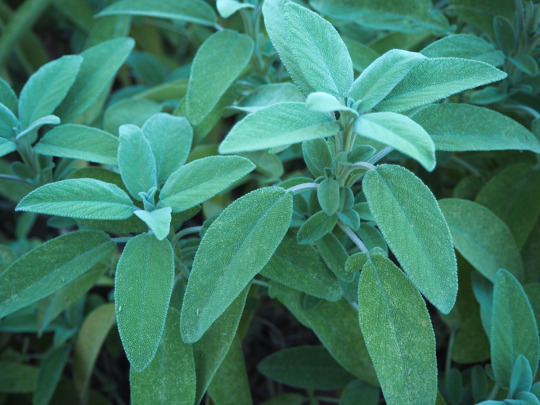
View On WordPress
0 notes
Note
since point coloration is temperature-based, how far can that go? will a pointed cat be super light if raised in a high heat environment, and vice versa? I wonder how dark pointed cats can get… but that would probably require extremely unpleasantly cold conditions
The way the color restriction genes work is through manipulating activation of the tyrosinase enzyme which plays a critical role in pigment production. The mutation prevents it from working at normal body temperature (100.5 - 102.5F) resulting in reduced pigmentation but will function normally at cooler locations (lower than ~91.5F).
It isn’t as simple as hot = light and cold = dark, ambient and body temperature both play a role. Colorpoint kittens are born solid white because their temperature and their environment (in the womb) are both hot.
Bit there’s also a degree of individual variation for reasons… that I don’t really know? Someone else might, or maybe the rest of the world is as clueless as me.
For example when a pointed cat is shaved for a procedure the fur will grow in dark because the skin is exposed, meaning it isn’t as well insulated and will be cooler.

My favorite example of this Quattro, a cat @followthebluebell shared from his work. Here’s a link to the post about him, along with another example in a snow lynx Bengal.
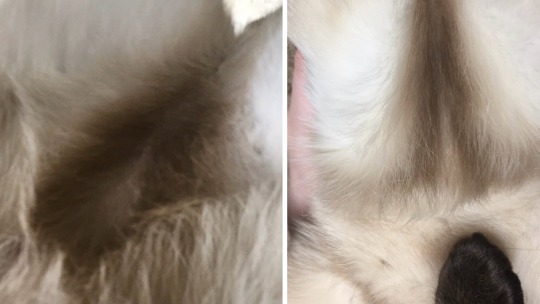
And here’s a less extreme example of dark-colored regrowth in a seal point Tonkinese from work during a visit with us sometime after her spay.
So.
Then are shorthaired pointed cats not consistently darker than longhaired ones? Why do pointed sphynx not appear near-solid? One of the darkest colorpoint’s I’ve met is a longhair cat.
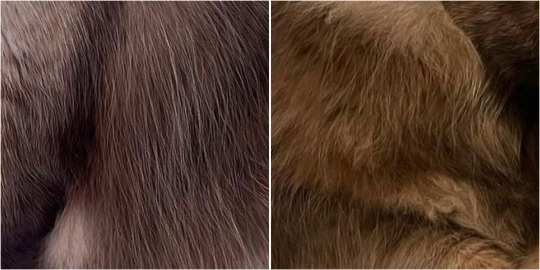
Here’s a Sphynx kitten (Left) compared to an Siamese kitten (Right). Their coloration appears to be developing at a similar pace.


It seems like part of the variety may be based on the “normal” of the individual cat?
One time we had a seal point board with us and she was having a sort of inflammatory reaction on her lip - it was awhile ago, I don’t remember exactly what the issue was - and the fur on her muzzle became much lighter until the issue was resolved and grew back in normal.

So I guess this was a long winded way to say… I ‘unno?
57 notes
·
View notes
Text
What To Know Before Writing an Albino Character
1) General Information:
Albinism is a genetic disorder that results in decreased production of a pigment called melanin in the skin, hair, and eyes, resulting in light color or no color. Albinism is not a disease, nor do people "suffer" from it — though every albino person has their own thoughts and feelings regarding their condition. There's no cure for albinism. People with albinism are more likely to be diagnosed with skin cancer, as well as dealing with things like sun burns, but besides sight problems and eye sensitivity, most people with albinism are just as healthy as everyone else.
People with albinism are typically diagnosed at birth, as doctors can tell by their appearance. If albinism is suspected, a doctor can order a genetic test to get the most accurate results regarding type and gene mutation. Due to eye complications that come with albinism, some doctors will asks for babies to be seen by optometrists. During those eye examinations, doctors can find out if the patient has rapid eye movement, sensitivity to bright light, or misalignment of the eyes. Most people with albinism have photophobia (extreme sensitivity to bright lights), refractive errors (such as astigmatism, myopia, hyperopia), nystagmus (involuntary movement of the eyes, which can lead to abnormal head positioning), or strabismus (misalignment of the eyes).
Due to low or reduced melanin, people with albinism are extremely vulnerable to UV sun damage. To avoid damage from the sun, people with albinism are advised to wear protective clothing, hats, and sunscreen.
Along with that, people with albinism wear glasses that block out UV rays. They also use softer lights in their homes and on their electronic devices. Some albinos experience pain or headaches after being exposed to intense bright colors or eyestrain, which causes them to lean more towards pastels when regarding things they'll have to look at a lot.
People do not always like being referred to as albino, sometimes preferring the term "person/people with albinism." Many don't care, but it's overall regarded as disrespectful and sometimes derogatory to call someone "an albino/albinos" rather than an albino person or the previous listed term.
2) Types of Albinism:
There are two main types of albinism: oculocutaneous albinism (OCA) – the most common type, affecting the skin, hair and eyes, and ocular albinism (OA) – a rarer type that mainly affects the eyes. OCA is the type of albinism that most people are familiar with and that is represented more in the media. People with OA typically look the same as non-albino people, with the exception of their eyes. However, some do have slightly ligher hair and skin colors from their family members, but not by a very big extent. Their visual acuity is typically lower than normal, ranging from 20/60 to 20/400.
OA1 is caused by a change in the GPR143 gene that plays a signaling role that is especially important to pigmentation in the eye. OA1 follows a simpler pattern of inheritance because the gene for OA1 is on the X chromosome. Females have two copies of the X chromosome while males have only one copy (and a Y chromosome that makes them male). To have ocular albinism, a male only needs to inherit one changed copy of the gene for ocular albinism from his carrier mother. Therefore almost all of the people with OA1 are males. While possible if the mother is a carrier of ocular albinism and the father has ocular albinism, it is extremely rare.
As for OCA, there are currently seven forms of oculocutaneous albinism recognized – OCA1, OCA2, OCA3, OCA4, OCA5, OCA6 and OCA7. Some are further divided into subtypes. For OCA, both parents must carry the albinism gene for their child to inherit the condition.
OCA1, or tyrosinase-related albinism, results from a genetic defect in an enzyme called tyrosinase. This enzyme helps the body to change the amino acid, tyrosine, into pigment. (An amino acid is a “building block” of protein.) There are two subtypes of OCA1. In OCA1A, the enzyme is inactive and no melanin is produced, leading to white hair and very light skin. In OCA1B, the enzyme is minimally active and a small amount of melanin is produced, leading to hair that may darken to blond, yellow/orange or even light brown, as well as slightly more pigment in the skin.
OCA2, or P gene albinism, results from a genetic defect in the P protein that helps the tyrosinase enzyme to function. People with OCA2 make a minimal amount of melanin pigment and can have hair color ranging from very light blond to brown.
OCA3 is rarely described and results from a genetic defect in TYRP1, a protein related to tyrosinase. People with OCA3 can have substantial pigment.
OCA4 results from a genetic defect in the SLC45A2 protein that helps the tyrosinase enzyme to function. People with OCA4 make a minimal amount of melanin pigment similar to people with OCA2.
OCA5–7 were recognized in humans in 2012 and 2013. They have reported mutations on three additional causative genes. As gene testing becomes available, and more people with these types of albinism are identified, the complete range of physical manifestations will be recognized, and may overlap with other known types of OCA. Currently, these types of albinism are considered to be uncommon.
Albinism occurs in all race and ethnic groups across the world, but there are some types that are more common amongst certain groups. The most common types of albinism found in the black population of Southern Africa are OCA2 and OCA3. OCA3 is also the most common type found amongst Asian populations. It's important to do research on people with albinism who are the same ethnic/racial group as your character(s) to make sure you are representing them correctly as albinism looks different for each group of people.
As a side note, it's important to know that people with albinism do not always have red eyes. Even those who appear to have red eyes don't actually have that eye color, but it's rather a result of the lack of pigment, which makes the iris paler and thus, the retina more visible. People with albinism can have pretty much any eye color as long as it's a light shade; I've personally met other albino people who've had blue, red, pink, green, purple, and even yellow. In pictures, however, they eyes typically always appear some shade of red.
3) Recognize How People With Albinism Are Treated:
In places like China, having albinism is considered bad luck and many who have it are ostracized and excluded from mainstream society. They're also considered unattractive and inferior to many. Besides their physical disabilities, many Chinese people with albinism say that finding a partner is their biggest struggle.
Africa is one of the most dangerous places for albino people. In West Africa, some communities and families consider it a misfortune to give birth to Albinos and hence, attempts are made to either kill them at birth or banish them from the community. They are constantly abused and ridiculed by the public with derogatory names and social tags that serve as a form of stigmatization.
In many countries of sub-Saharan Africa, people with albinism suffer discrimination and ostracism and are seen as a curse. Many superstitions look at people with albinism as a source of income, so they are mutilated and the parts of their bodies are used in rituals of black magic, under the belief that they give wealth and fortune to those who own them. Some cultures believe that they do not die, but disappear, or that having sex with a person with albinism cures AIDS — which causes a high rate of sexual assault amongst those with albinism.
Not all places view albinism as bad though. In Panama, many people view those with albinism as lucky. In America, many people don't may much mind to those with albinism besides staring and making comments.
Overall, it's worthy to note how people with albinism are treated in the country your character(s) live in. Albinism dictates a lot in people's lives, but for some it can be the cause of their death or severe injury and trauma. People with albinism don't want extensive descriptions of their own trauma, but it's important to not gloss over how they're treated. If your character is from a fantasy setting then you can attempt to reflect how they're treated by looking at countries in the real world most similar to your fictional one.
4) Things To Avoid:
In Hollywood, people with albinism are often depicted as evil. It's become very rare that someone with this condition is viewed positively, they're always either a villain or a comedic relief character whose condition is used to mock them. Avoid both of these as much as you can. If you'd like to make your character with albinism a villain, make them compelling and give them a justifiably reason for their path: don't just make them someone whose naturally evil. If they're comedic relief, don't make them being albino apart of their jokes — give them a personality and make them likable.
Don't make them albino just because you think it's cool. Almost every person with albinism identifies as disabled and it's important to showcase their struggles, specifically with their sight and how they interact with situations that involve bright lights and such. Make sure you're not making them into a pity show, though, as disabled characters shouldn't solely revolve around their disabity. A good example of a character whose disability is a main part of her character but not the only part of it is Toph Beifong from Avatar: The Last Airbender, who is blind like many albino people. That's not to say that people with disabilities are or should be defined by their struggles, but that those struggles are real and often difficult to navigate. They are part of us and help to make us who we are. It might just be my opinion, but if you can ignore all their hardships then that's not an authentic portrayal of anything, really.
People with albinism are also very likely to be bullied for their appearance and viewed as unattractive, so it can be very positive representation to show your albino character as attractive. They don't have to be the most beautiful person in the cast, nor should you fetishize them for being disabled, but it can be nice to show other characters having feelings for them or giving them a romantic partner.
And most importantly, don't make them albino for no reason. Why does your character have albinism? What character or narrative purpose does it serve? How would the story be different if they didn't have albinism? Ask yourself these questions, and if you can't come up with good answers then maybe your character shouldn't have albinism. Think about how being albino affects them, the people around them, their story, and the overall plot. Are you making them albino for the sake of seeming diverse and woke or because you want to represent this group of people?
If your story is leaning into fantasy then you can come up with very easy explanations for why your character is albino. Maybe their people live underground and evolving to have albinism was what as best for their survival. Maybe your character is a clone, in which case they don't need their parents to have the albinism gene.
5) Closing Notes
This is just a general overview for people to get started on writing their albino characters. It's important to talk with actual albino people as you continue writing. Please do your own research on people with albinism to get more detailed insight on the condition.
If you're making a professional piece of work then you consider hiring an albino sensitivity reader to help ensure your depictions are appropriate. If there's anything you're unsure of in the meantime, researching or asking an albino person is best.
#if anyone with albinism has anything to add feel free!!#writing advice#albino characters#albinism#actually albino#albino representation#writing tips#oh and im albino just in case it wasn't clear#aloeverants
336 notes
·
View notes
Text
r/mushroom user asks: “why TF are these guys purple?”

Cortinarius sp.?
MCX Answers:
Great question!
IMO: The color of mushroom fruit bodies, especially in terms of their penetration colors (color changes upon bruising or cutting), is influenced by the presence of certain chemical compounds. The primary compounds responsible for these color changes are secondary metabolites, such as polyphenols and enzymes.
When a mushroom is injured or bruised, these compounds come into contact with oxygen, leading to oxidation reactions. This oxidation can result in the formation of new pigments and changes in color. For example:
1. Tyrosinase Enzyme: Mushrooms often contain the enzyme tyrosinase, which plays a role in the production of melanin. When the mushroom tissue is damaged, tyrosinase reacts with compounds like tyrosine to form melanin, leading to darkening or browning.
2. Polyphenols: Certain mushrooms contain polyphenolic compounds that can undergo enzymatic reactions, causing color changes upon exposure to air. This process is often seen in the browning of mushroom flesh.
3. Other Compounds: Specific mushroom species may contain unique compounds that contribute to distinct colors upon bruising or cutting.
The specific colors observed can vary among mushroom species due to differences in their biochemical composition. Factors such as genetics, environmental conditions, and the age of the mushroom can also influence the color changes.
Further… biological adaptation!
The pigmentation of mushroom fruit bodies can have evolutionary significance, although the specific adaptive reasons for coloration can vary among different mushroom species. Some evolutionary considerations for pigmentation in mushrooms:
1. Camouflage and Mimicry: Some mushrooms may have evolved to blend in with their surroundings, providing them with a degree of camouflage. This adaptation could help protect them from herbivores or increase their chances of successful spore dispersal.
2. Warning Colors: In contrast, certain brightly colored mushrooms may serve as warning signals to deter potential herbivores. This is often seen in toxic or poisonous mushrooms that have evolved to display vivid colors as a way of indicating their unpalatability.
3. Attraction of Dispersal Agents: The colors of mushrooms can also play a role in attracting specific dispersal agents, such as insects or animals. Some mushrooms have evolved to produce pigments that attract these agents, aiding in spore dispersal.
4. Environmental Adaptations: Mushroom pigmentation may be influenced by environmental factors, including light exposure. The color of a mushroom might be adapted to enhance its ability to thrive in a particular habitat or microenvironment.
5. UV Protection: Pigments can act as a form of protection against ultraviolet (UV) radiation. Some mushrooms produce pigments that may help shield them from the potentially harmful effects of UV light.
It's important to note that the evolutionary reasons for mushroom pigmentation can be complex and multifaceted, and they may vary greatly among different species.
#mycology#magic mushies#microbiology#mold#60s psychedelia#lgbtqia#lgbtqia2s#lgbtqia2s+#myc#enby#fungi#fungus#enzymes#biology#science#queer#trans#non binary#mushroom#cortinarius
29 notes
·
View notes
Text
Ball Python Morphs pt.1
Note: I am not a snake breeder/owner, this is simply information and photos i have found online and believe to be factual after researching. If i get anything wrong, please tell me and i will correct or remove it :)
Important morph health issues: HERE
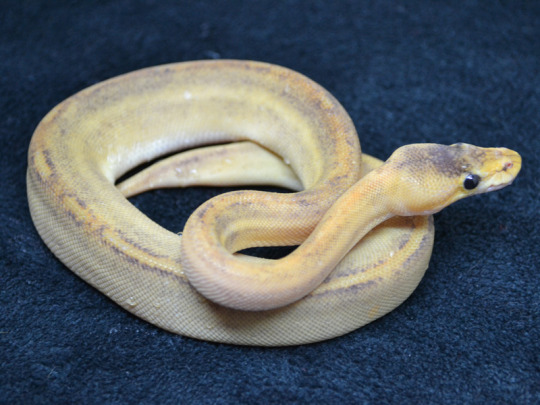
2X4/ CHAMPAGNE MAHOGANY
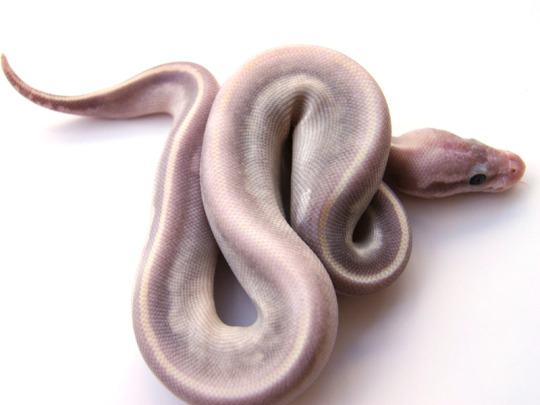
4P/ PASTEL PURPLE PASSION PINSTRIPE

50 SHADES OF GREY/ PEWTER BLACK HEAD/ BLACK HEAD CINNAMON PASTEL
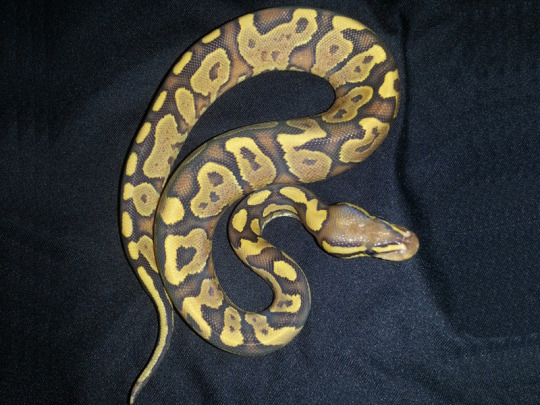
7 DOLLAR GHOST

8 BALL MATTER/ BLACK PASTEL CHAMPAGNE CINNAMON
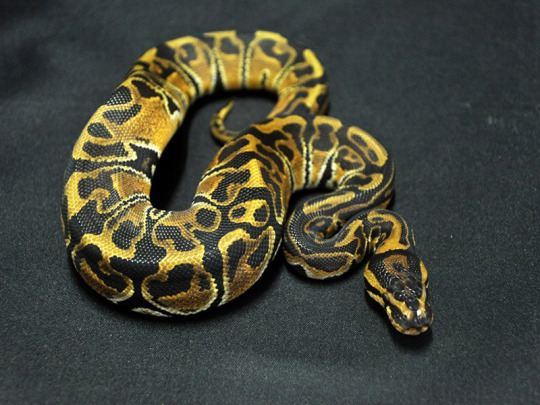
ARP

ABACUS/ ENCHI MAHOGANY
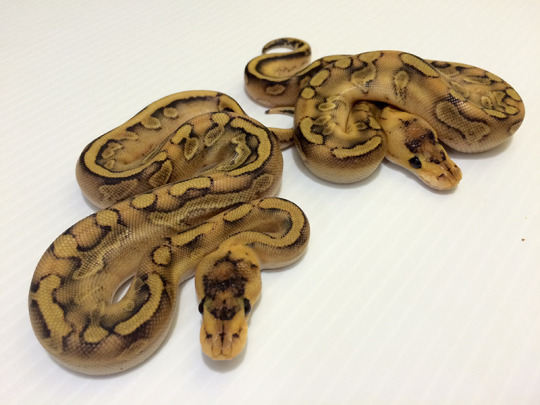
ACE BALL/ ASPHALT CHAMPAGNE ENCHI
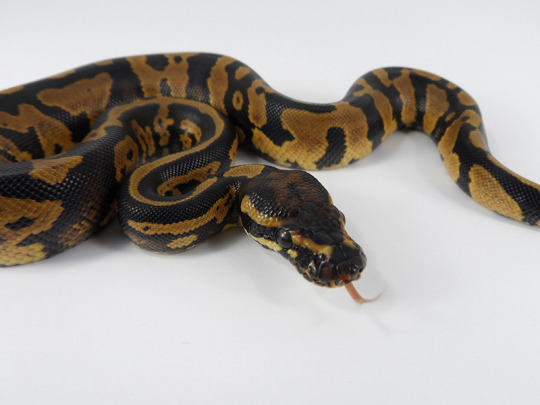
ACID

ACID DISCO/ DISCO ACID

ACID DISCO ENCHI

ACID FIRE PHANTOM

ACID LESSER

ADMIRAL'S BALL/ GHI LESSER PASTEL PINSTRIPE/ GHI EMPEROR PIN
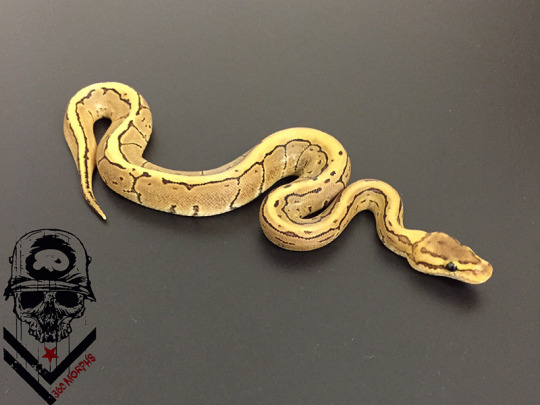
AFTER BURN/ ARROYO FIRE PINSTRIPE
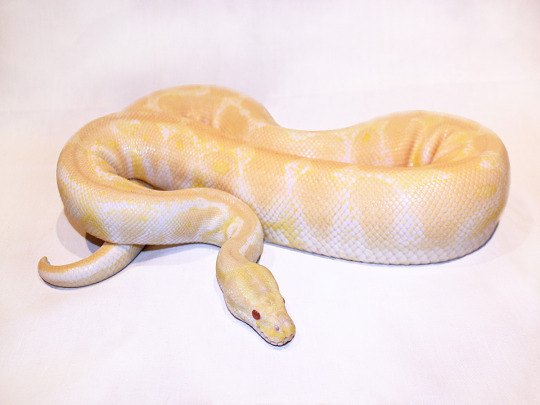
ALBINO/ AMELANISTIC/ TYROSINASE (T-) ALBINO

ALBINO- FADED/ PALE ALBINO

ALBINO- HIGH CONTRAST
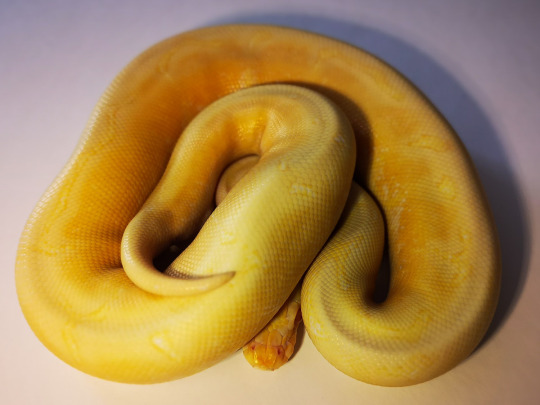
ALBINO- HIGH CONTRAST GHOST SPIDER/ SPIDER SUNGLOW

ALBINO-HIGH CONTRAST GRANITE (CO-DOM) HIDDEN GENE WOMA LESSER PASTEL/ PASTEL ALBINO SPIDER SUCKER

ALBINO ASPHALT CINNAMON

ALBINO AXANTHIC CHAMPAGNE- JOLLIFF/ SNOWPAGNE

ALBINO AXANTHIC CHAMPAGNE- VPI/ SNOWPAGNE

ALBINO AXANTHIC CINNAMON PASTEL- JOLLIFF
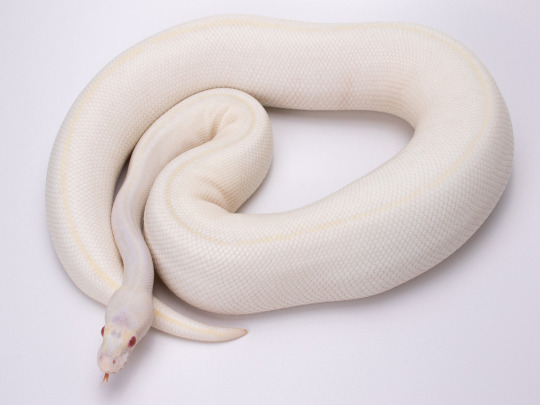
ALBINO AXANTHIC IVORY

ALBINO AXANTHIC PIEBALD VPI/ VPI SNOW PIED

ALBINO AXANTHIC WHITEWASH

ALBINO BAMBOO ENCHI
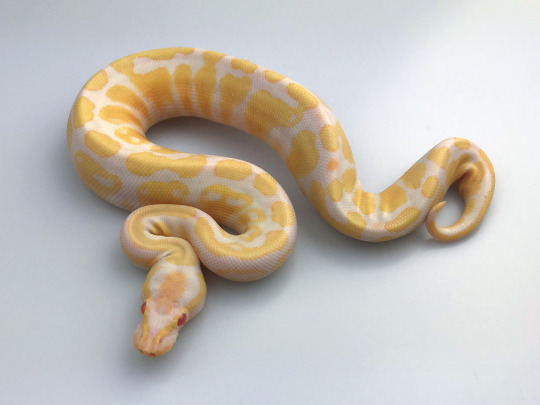
ALBINO BANANA

ALBINO BANANA BALL GENETIC STRIPE/ BANANA CREAM
#animals#exotic animals#snake#snakes#snakblr#snakeblr#ball python#royal python#ball pythons#royal pythons#snake morphs#morphs#ball python morphs
11 notes
·
View notes
Note
How you skin so clear bro? I'm tryna be a pretty lil bih like you 😭😭
“Pretty lil bih” is crazyyy😭
But anyway
Morning:
1. CeraVe cream to foam cleanser or CeraVe Acne Foaming Cream Cleanser
You just need something simple and gentle. If you’re having a break out, use something with salicylic acid or benzoyl peroxide (leave on for 3-5 minutes to allow the active ingredients to work)
2. Naturium Tranexamic Acid Brightening Treatment
Mostly for antioxidant support throughout the day. Antioxidants prevent free radical damage that can result in collagen breakdown. It contains tranexamic acid, alpha arbutin, and kojic acid -in addition to being antioxidants they are also tyrosinase inhibitors that prevent the formation of dark spots.
3. Sunscreen
Most important step! SPF 30 or higher
Just find something that works for you and apply it EVERY morning (~1/4 tsp or two finger lengths for the face and neck)
Night:
1. CeraVe cream to foam cleanser
2. Naturium Tranexamic Acid Brightening Treatment
3. Tretinoin (prescription) HOLY GRAIL
Topical retinoids are the gold standard for fighting acne, sun damage, and aging. It works on the cellular level to increase cell turn over, collagen synthesis, blood vessel formation. You must be consistent and it take 8-12 weeks before results are visible. 👨🏾🔬
Adapalene and other retinols are available otc. and can be more beginner friendly.
4. CeraVe Baby Lotion ( has similar ingredients to the their night cream but it has way more product for a better price lol)
Miscellaneous:
Paula’s Choice BHA or CeraVe Acne Control gels
These are exfoliants I use once or twice a week if my skin is dull or textured
A dermatologist is probably the best person to ask for skincare advice, so if you have access I highly recommend booking a consultation. They’re also teledermatology services that can things a bit more accessible.
Good luck bro 🧍🏾♂️🤎
21 notes
·
View notes
Text

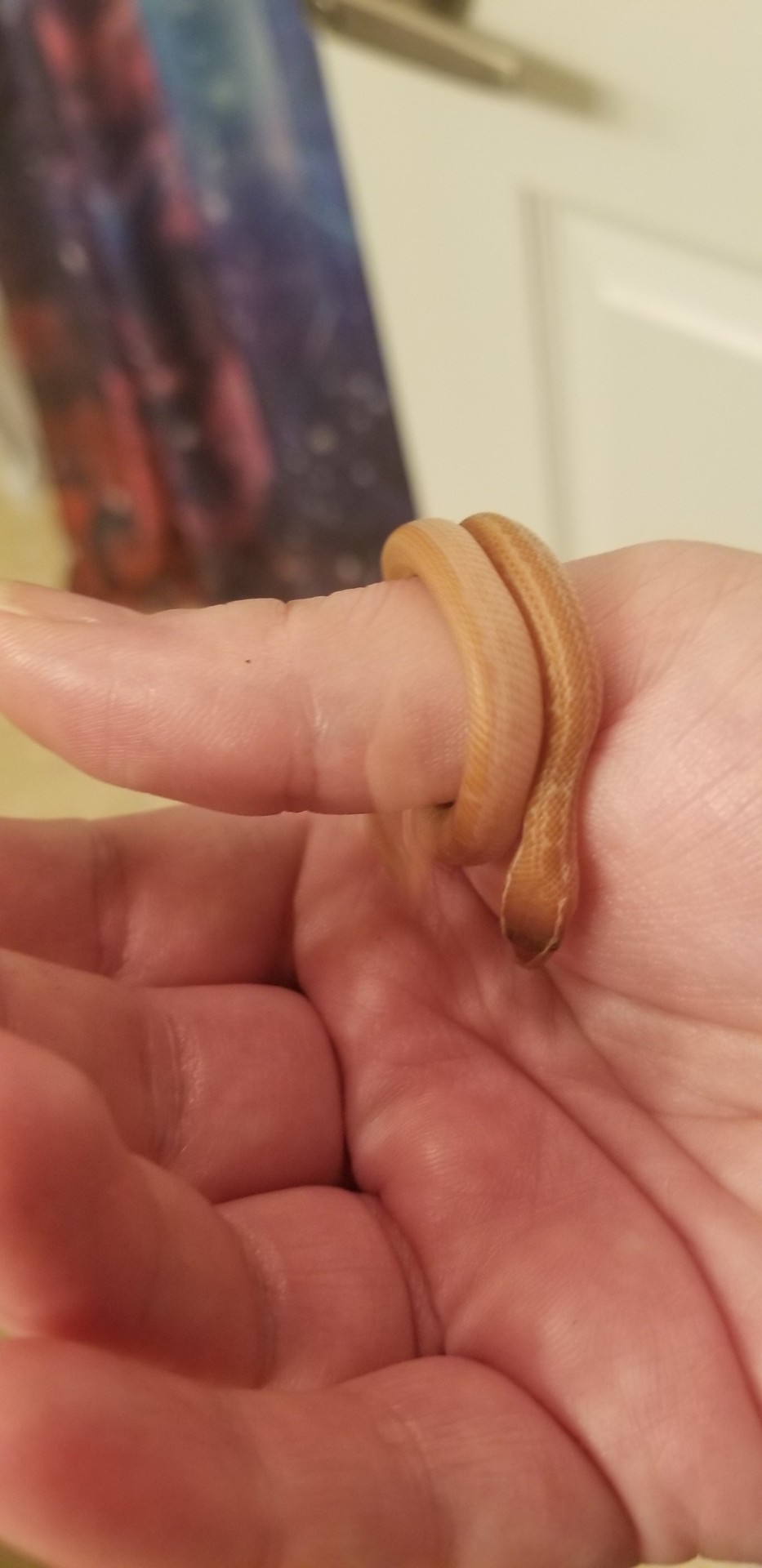
I got Wikus two years ago and look how he's grown!! He won't get a whole lot bigger, though.
Wikus is a tyrosinase-positive albino Cape house snake, a common, harmless noodle from South Africa and neighboring countries.
#snek#snakes#house snake#cape house snake#african house snake#reptiblr#reptiles#reptile#wikus#meatspace#pets#animals#albinism#albino snake
108 notes
·
View notes
Text
EVERYTHING ON EARTH HAS A PURPOSE
Written by: Sunshine Belizar

The most hated month of the year is June because of the falling mangoes. When I am cleaning our backyard, I’m irritated by the mango leaves that are falling, even the fruit. Mango trees produce fruit, which is good; however, when the fruit falls from the tree, it can create a mess in our yard. The fallen fruit can be rotten and attract undesirable pests, such as rats and insects.
Having a mango tree in our backyard means it be difficult to maintain. Mango trees can also destroy infrastructure if they're too close to your house or any other buildings. It can also destroy the lines of electricity that are passing through the branches and leaves. In addition, the tree can drop fruits or branches onto the house, which can cause damage to the roof or other parts of the structure.
However, along with the disadvantages, there are always advantages. According to the study of Atienza (2021) that the local mango leaf extracts found as potential anti-aging, skin-whitening cosmetic ingredient. The research team studied the presence of polyphenolic compounds in the local mango leaves. It also looked into the local mango leaves’ antioxidant capacity and inhibitory effect against elastase and tyrosinase, enzymes that cause aging and darkening of skin. "Previous studies on foreign mango cultivars reveal that mango leaves are excellent source of polyphenolic compounds, which provides health benefits such as antioxidation, antidiabetic, anti-cancer, and anti-inflammatory properties, among others," the DOST- Science and Technology Information Institute (DOST-STII).
With those citations, given the nature of life, we are unable to stop time. Even individuals of color, especially those with dark skin, are more likely to experience prejudice, neglect, and even discrimination by society here in the Philippines. Lighter skin is more respected than those who have dark skin. Because of the norms, people with dark skin are even using products like soaps and cosmetics to make them light skinned. They tend to use money only to be accepted by society. In life, don’t always look at the downside from a negative perspective; always think positively. Everything here on earth has a purpose, even if we hate that it exists. We cannot change it because it is already here on earth. I don’t expect that mango leaves can be helpful to people, especially to our skin. Likewise, I hated the mango tree because it was hard to maintain and messy. But it gives us benefits like food, shelter, medicine, and many more. My teacher once said that everything that we see today has its purpose here on earth; if one perspective, one thing, or even animals or human beings are extinct here on earth, the function of the earth will not function that way before. Overall, I appreciate what we see today, and when the time comes that we go extinct, at least we experienced what was before.
Reference: https://mb.com.ph/2021/05/07/local-mango-leaf-extracts-found-as-potential-anti-aging-skin-whitening-cosmetic-ingredient-study/?fbclid=IwAR2h0-X1ZRzCSjTSD0t0mv3H-eCbIw_o3fdy78AFmak1wZ2DQbzaQP-ekzY
3 notes
·
View notes
Text
The Bangkok mocha pattern
Beside the quite common colorpoint and the somewhat common sepia pattern (and the fortunately very rare albino), the color restriction gene has one more recently discovered allele: it’s called mocha. These alleles are all intermediate with each other, and together they can produce six different phenotypes, as messybeast illustrates it:

Here's the story of this new coloration:
The Bangkok Mocha cat story began with an accidental discovery. I was working on improving the health of my American Burmese and to do this, I was importing Burmese cats from Thailand. My contact in Thailand reached out and said he had rescued a mother cat and her three kittens. The mom was a tortie of some sort and she had two sable daughters and one tortie sable daughter. He asked if I wanted them and I said sure, send them to me. Once they got Washington, DC, I had them genetically tested to see what their coat color genetics were. […] When I got their results back, I was perplexed. Their genetic coat color tests revealed they were black cats. However, the three cats were anything but black. […] [They] inherited a mutation that had yet to be identified.
[…] I kept breeding these cats, and was able to import more cats from Thailand that carried the gene. I now have a genetically diverse breeding colony of these cats. I decided to call them Bangkoks, because the first three discovered came from Bangkok. It seemed only appropriate they should be named after the place to which they were native. As time passed, the gene was identified. It was called (cm) or mocha. So, I decided to call them Bangkok Mocha’s.
(extract and pictures from bangkokmochacats.com)
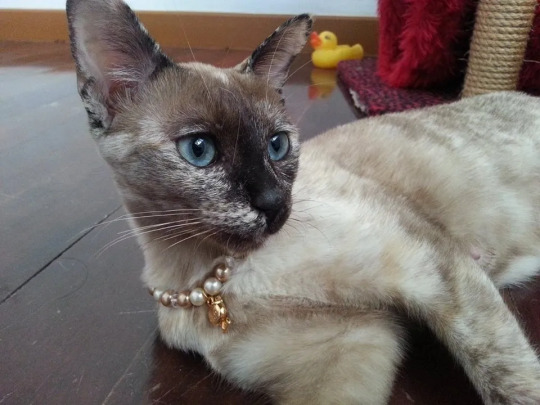

The original tortie mother and her three daughters. They are sepia/mocha heterozygotes.
Some mocha-carrying cats of various colors:




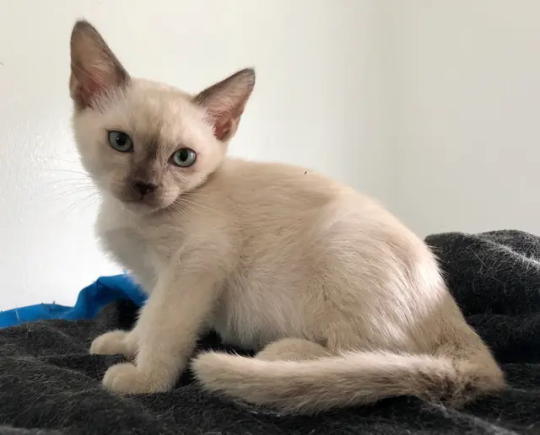


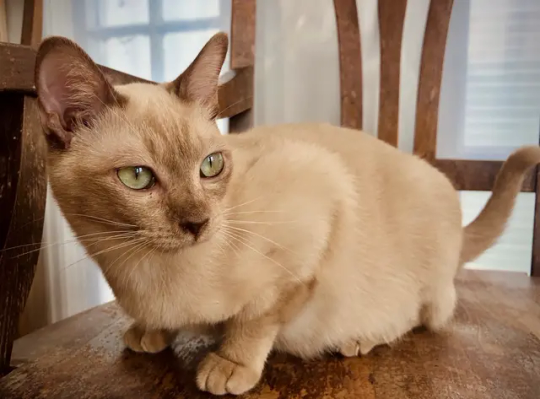



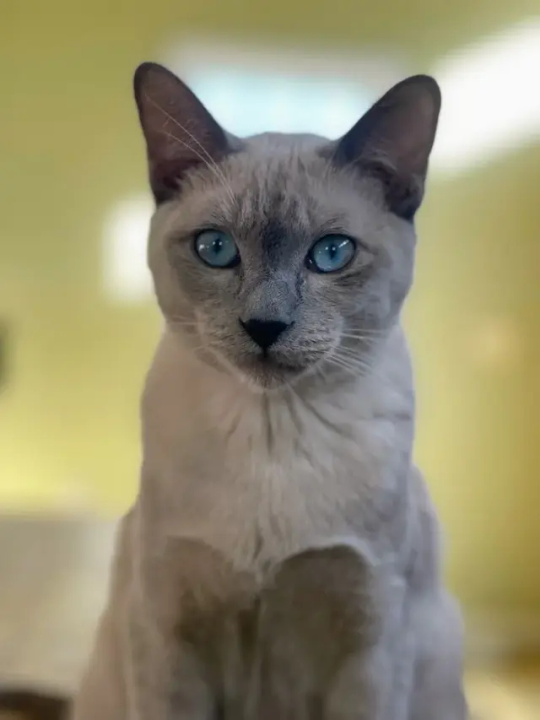

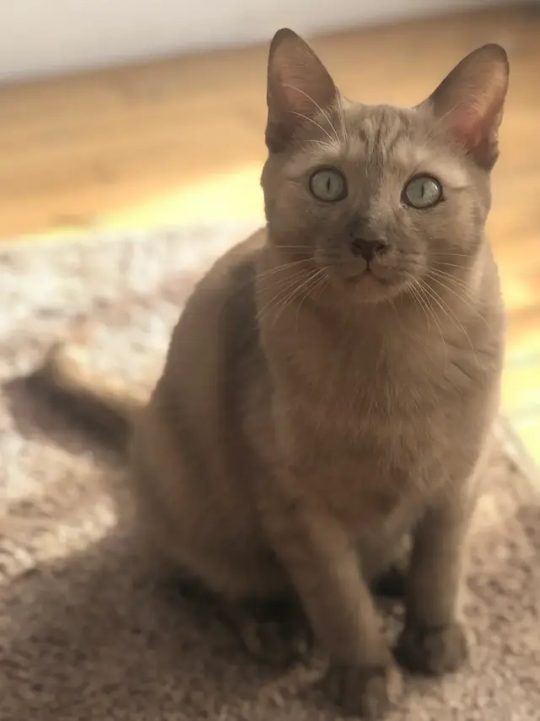
In 2019, Yu, Y et al. identified a mutation on the tyrosinase (color restriction) gene associated with the mocha phenotype.
#cats#cat genetics#a little genetics for tonight#color restriction#mocha#i really like these cats they seem very elegant#i hope i'll see this coloration in real life once
40 notes
·
View notes
Note
Hi there ! Can you explain how the cat in this post is a cream lynx point? I think it may be the color settings on my laptop ( or just my eyes in general haha,) but it just looks white ! Sorry if it's a bit of a silly ask, just curious 😊
https://www.tumblr.com/felinefractious/732920052314161152/varenik-tzar-koshka-neva-masquerade?source=share
The colorpoint gene (cscs) is a form of temperature dependent albinism.
Tyrosinase is an enzyme that's important in pigment production, but the colorpoint makes this enzyme sensitive to temperature. It is shut down in warm areas and allowed to function in cool areas.
The face, legs and tail are furthest away from the cat's core and loose heat more quickly which is why they develop more darkly into the signature pointed coloration.
All of this is to say that pointed cats are born white because, well, it's warm in the womb!

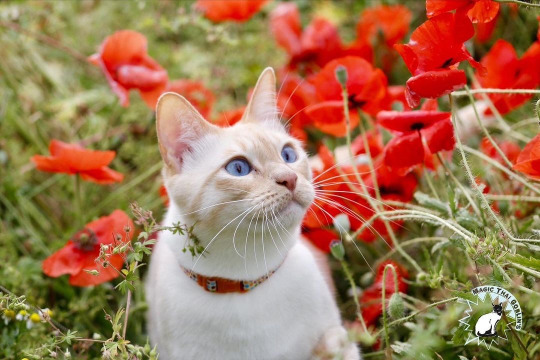
Left: Neva Masquerade kitten || Right: Thai cat
So the kitten pictured is still growing into their points, it doesn't help that cream is already a light shade and the cat has longhair which can further mute/muddy the coloration/pattern.'So the kitten pictured is still growing into their points, it doesn't help that cream is already a light shade and the cat has longhair which can further mute/muddy the coloration/pattern.
9 notes
·
View notes
Text
How to make whitening cream for business?

Even though being outside in the sun feels good, it can be very bad for your face. Even though skin cancer is a big health concern, the sun can also make your skin darker or give you dark spots. Best of all, you probably already have everything you need to make one in your home. If your skin is oily, try making a simple skin whitening cream with lemons. If your skin is dry, try nuts.
You can't stress enough how important it is to take care of your face. It's the biggest organ in the body and the first line of defense against sickness and infection. So, if you see spots, dark spots, or other problems with the color of your skin, you should do what you can to stop further damage. The good news is that you can fix many color issues on your own. This piece will talk about eight things you can do at home to lighten your skin and get rid of any dark spots or spots that don't look good.
Whiten the Skin with Citrus Extracts
Lemon juice and orange peels can be used to naturally lighten the face. They have a lot of vitamin C, which is important for making the collagen fibers for face whitening creams that keep your skin tight and help it stay strong. When put on the skin, vitamin C has been shown to slow down melanocytes that are working too fast. These are the cells in the lower layers of the skin that make melanin, which makes the skin "tan" or get darker.
Kojic Acid
kojic acid is a white, crystalline powder that comes from a fungus in Asia. It has been used in Japan for a long time as a natural alternative to hydroquinone and is very good at lightening dark spots on the face. The American Academy of Dermatologists says that clinical tests have shown that kojic acid can lessen hyperpigmentation. It works by stopping tyrosinase, the protein that makes melanin, from doing its job. It also works as an antioxidant and is good for skin that has been hurt by the sun or is sensitive.
Licorice Extract
In Chinese medicine, the juice made from the roots of the licorice plant has been used for a long time to treat all kinds of skin problems. In the early 1990s, Japanese scientists found the compound glabridin in licorice. This compound blocks UVA and UVB rays and makes the skin whiter and brighter.
A clinical study that was released in the Journal of Agricultural and Food Chemistry showed that glabridin could block the enzyme tyrosinase, which makes melanin, by up to 50% without hurting skin cells. Licorice extract is good for treating post-inflammatory hyperpigmentation, which includes dark spots. It can use to reverse the damage that cause by acne scars, and it has anti-inflammatory qualities that help soothe the skin and reduce redness.
Extract of Bearberry
This part of the plant comes from the leaves instead of the fruit. Bearberry, also called bear grape, is an astringent that uses in many beauty products. It includes Alpha arbutin, which is known to lighten the skin quickly.
It shows that arbutin can reduce freckles, dark spots, and other skin problems. A study done by the drug company Pentapharm found that 1% Alpha arbutin had a "skin-lightening effect" that was even better than the same dose of hydroquinone.
Bearberry extract is also helpful because it includes filters that protect against the sun. These filters may help reduce the amount of "tanning" after being in the sun, which can slow or even reverse signs of aging on the skin.
The Gooseberry (Phyllanthus Emblica).
The extract from this plant is full of Vitamin C and has antimicrobial and antioxidant qualities. Emblica extract keeps the skin from getting damaged by the sun and helps remove discoloration.
Researchers have found that Emblica protects the skin from oxidative stress, reduces wrinkles, controls the production of melanin, and helps the skin keep its natural wetness.
The Gigawhite
Gigawhite is a brightener for the face that has a patent and works well to treat dark spots and melasma. It comes from seven Swiss mountain plants that grow in an organic way. These plants include peppermint, common mallow, and primula (cowslip).
Extract the White Mulberry
The white mulberry tree (Morus alba) is from China and has been found to be good for your health in many ways. It can also help whiten the face and protect against heart disease, high cholesterol, and diabetes.
Vitamin B3 (Niacinamide)
Niacinamide, another name for vitamin B3, stops the production of melanin, a pigment. When added to face creams, it also works well to lighten the skin. When put on the skin, vitamin B helps it keep water. Water makes it feel softer and smoother and reduces fine lines.
Most things you can buy online will have a full list of the ingredients to take a quick look at it before you buy. The ingredients you choose will, of course, rely on what you want to happen.
Then after making, the most important thing is that how to pack your cream? so I suggested you to use customize boxes for cream which play an important role in protecting as well as promoting your product.
So, There are a lot of man-made chemicals in the face brightening creams that you can buy. Even though they are made with approved formulas. They still have many stabilizers and chemicals we don't want. So, in this post, we'll look at some ideas you can use to make your own skin-brightening cream at home.
2 notes
·
View notes
Photo

Jewel Plummer Cobb (January 17, 1924 – January 1, 2017) was a biologist, cancer researcher, professor, dean, and academic administrator. She contributed to the field of cancer research by studying the cure for melanoma. She was an advocate for increasing the representation of women and students of color in universities, and she created programs to support students interested in pursuing graduate school. She was the only child of Frank V. Plummer and Carriebel Plummer. Her mother, Carriebel, found employment as a physical education and dance teacher who graduated from college with a BA in interpretive dancing. Her father, Frank, was the first African American to graduate with a DM from Cornell University, becoming a physician specializing in dermatology. She matriculated at the University of Michigan, but, dissatisfied with segregated housing for African-American students at Michigan, she transferred to Talladega College. She graduated with a BA in Biology and became a member of the Alpha Kappa Alpha Sorority. She initially was denied a fellowship for graduate study in Biology at NYU, due to her race, but was granted the fellowship after an interview. She earned her MS from NYU and her Ph.D. degree with a focus on Cell Physiology. Her dissertation, Mechanisms of Pigment Formation, examined melanin pigment granule formations in vitro using the enzyme tyrosinase. She was appointed an independent investigator at Woods Hole Marine Biological Laboratory. She was appointed President of California State University, Fullerton where she began to improve campus facilities from the start of her term. She was survived by her only child, a radiologist specializing in magnetic resonance imaging. #africanhistory365 #africanexcellence #alphakappaalpha https://www.instagram.com/p/CnhEKJnr4Vy/?igshid=NGJjMDIxMWI=
2 notes
·
View notes